You’ll discover that orchids offer endless possibilities for elevating your home’s aesthetic appeal, far beyond the typical windowsill placement. These versatile plants can transform any space into an elegant showcase, whether you’re working with a compact apartment or a spacious home. From creating eye-catching table centerpieces to designing modern vertical displays, your orchid arrangements will captivate guests while expressing your personal style. Let’s explore how you can master these sophisticated display techniques.
Contents
- 1 Creating a Stunning Orchid Centerpiece for Your Table
- 2 Natural Light Placement: Where to Position Your Orchids
- 3 Modern Shelf Arrangements and Vertical Displays
- 4 Pairing Orchids With Other Home Decor Elements
- 5 Creative Container and Planter Solutions
- 6 Color Coordination: Choosing the Right Orchid Varieties
- 7 Maintaining Your Orchid Display’s Beauty Year-Round
Creating a Stunning Orchid Centerpiece for Your Table
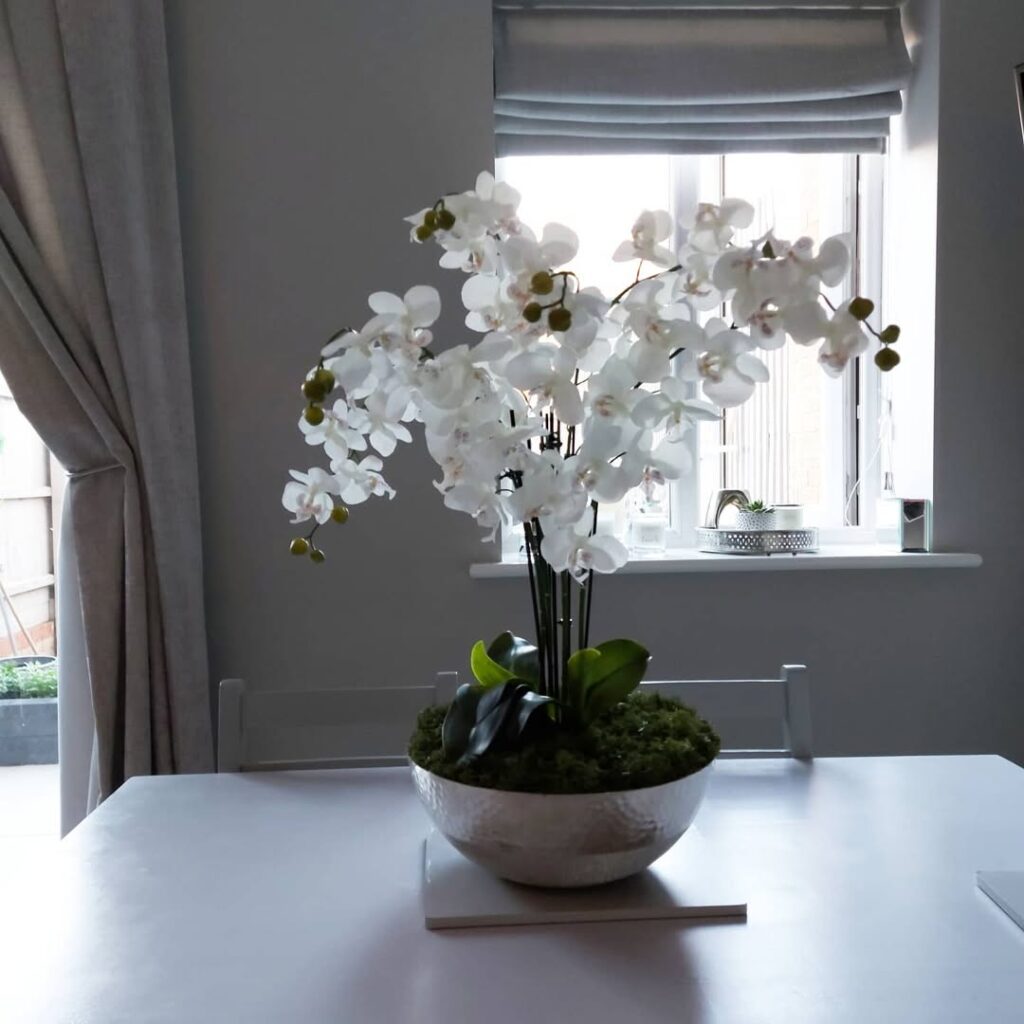
When you’re ready to create an eye-catching orchid centerpiece, start by selecting a low, wide container that’s 10-12 inches in diameter and 4-6 inches deep. Fill it with 2 inches of orchid bark mix, then position 3-4 orchid plants at varying heights to create visual interest.
Add preserved moss between the plants to cover exposed bark and create a polished look. If you’re using Phalaenopsis orchids, space them 4 inches apart, allowing their arching stems to create natural curves. For extra dimension, incorporate small air plants or delicate ferns as accent pieces.
Keep your centerpiece looking fresh by misting it lightly twice weekly and rotating it 45 degrees every few days.
Natural Light Placement: Where to Position Your Orchids
Proper light placement can make the difference between thriving orchids and struggling plants that refuse to bloom. You’ll want to match each orchid species with its ideal light exposure, as Phalaenopsis orchids prefer bright, indirect eastern light while Cattleyas thrive in stronger southern exposures. Before positioning your orchids, take time to evaluate your windows’ natural light patterns throughout the day, noting which spots receive gentle morning rays versus intense afternoon sun.
Best Window Exposure Spots
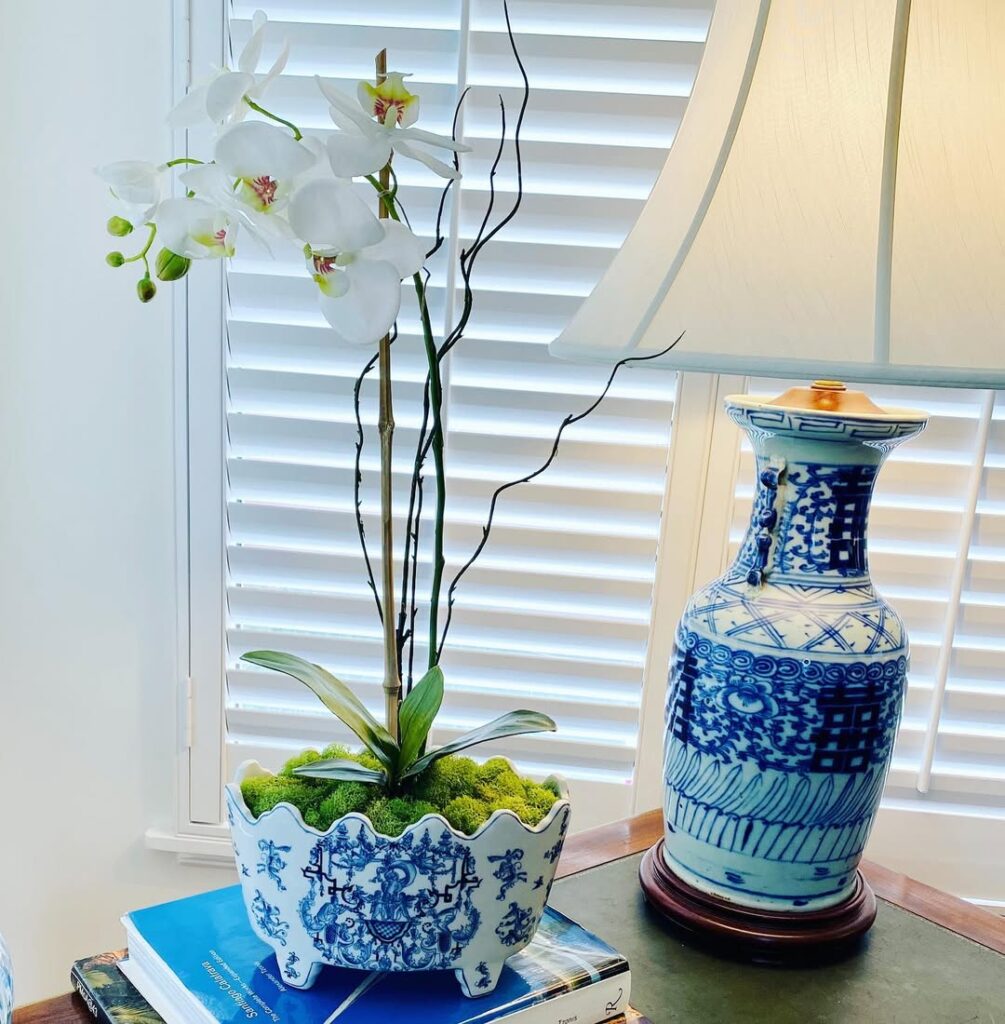
Finding the perfect window spot for your orchids makes all the difference in their health and blooming success. East-facing windows are your best option, providing gentle morning sunlight without the harsh afternoon heat. Place your orchids 6-12 inches from the glass for ideal exposure.
South-facing windows work well in winter but require sheer curtains during summer months. If you’re using west-facing windows, position orchids at least 3 feet back to avoid leaf burn. North-facing windows typically don’t provide enough light unless you’re growing low-light varieties like Phalaenopsis.
Remember to rotate your orchids 45 degrees weekly to promote even growth patterns.
Light Intensity By Species
Different orchid species have evolved to thrive in specific light conditions, from deep forest shade to bright canopy edges. You’ll find Phalaenopsis and Paphiopedilums prefer low light (1,000-2,000 foot-candles), making them perfect for north-facing windows or 3-4 feet back from east-facing ones.
Cattleyas and Dendrobiums need medium to bright light (2,000-4,000 foot-candles), so place them near east or west windows. For high-light lovers like Vandas (4,000+ foot-candles), south-facing windows work best, though you’ll need to provide shade during intense afternoon sun.
Check your orchid’s leaves – they’ll tell you if they’re getting proper light. Dark green means too little, while yellowish-green indicates too much.
Modern Shelf Arrangements and Vertical Displays
Transform your orchid collection into a stunning modern display with space-saving vertical solutions that’ll maximize both style and growing conditions. You’ll find floating wall shelves offer a sleek, contemporary look while keeping your orchids at eye level, with each shelf positioned 12-14 inches apart for ideal plant spacing. Glass display cases, measuring 24×36 inches with adjustable humidity controls, and powder-coated metal stands with 3-5 graduated tiers provide elegant alternatives that’ll protect your orchids while showcasing their beauty.
Floating Wall Plant Shelves
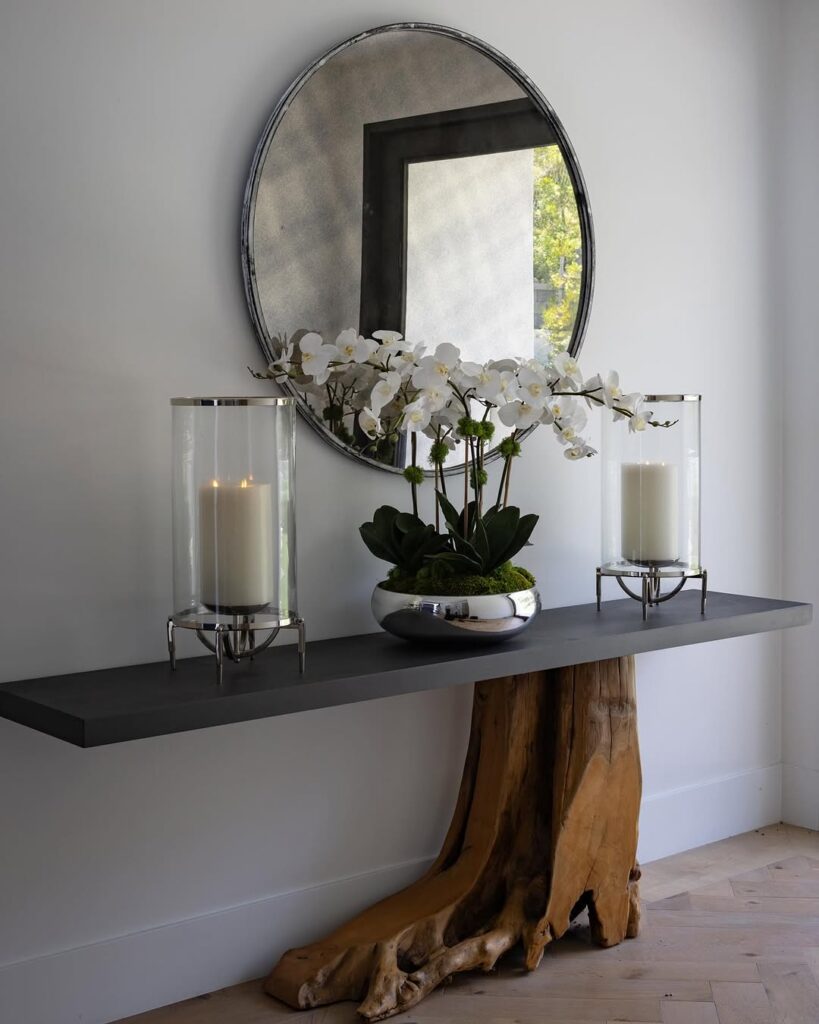
Sleek floating wall shelves create a contemporary showcase for your prized orchids while maximizing vertical space in any room. Install these minimalist platforms 12-16 inches apart vertically, ensuring each shelf can support at least 15 pounds of weight for your orchids and their containers.
Choose clear acrylic or natural wood floating shelves that extend 6-8 inches from the wall, providing enough depth for standard 6-inch orchid pots. You’ll want to position them near east or north-facing windows for ideal indirect light, keeping your plants about 3 feet from glass surfaces to prevent temperature fluctuations.
For extra stability, secure decorative L-brackets beneath longer shelves that exceed 24 inches.
Minimalist Glass Display Cases
Modern glass display cases take your orchid showcase from simple wall mounting to museum-quality presentation. Choose frameless cases with UV-protected glass, ideally 24″ x 24″ x 36″, to create a pristine environment for your prized specimens while protecting them from dust and drafts.
Install LED strip lighting along the top interior edges, spacing the strips 4″ apart for even illumination. You’ll want to position your cases at eye level, approximately 57″ from the floor, and maintain 65-75% humidity using small desktop humidifiers or humidity trays filled with pebbles and water.
Consider grouping three cases together for a striking visual impact, arranging orchids by color or species.
Tiered Metal Stand Designs
Three-tiered metal stands offer practical flexibility while maximizing your vertical growing space for orchids. You’ll find these stands in heights ranging from 24 to 48 inches, with each tier typically spanning 12 to 16 inches wide.
Position your most light-loving orchids, like Vandas and Cattleyas, on the top tier where they’ll receive ideal brightness. Place shade-tolerant Phalaenopsis on the middle level, and use the bottom tier for Paphiopedilums that thrive in lower light conditions.
For stability, choose stands with adjustable feet and rust-resistant powder coating. You can also add small LED grow lights under each tier to supplement natural lighting during darker months.
Pairing Orchids With Other Home Decor Elements
Pairing orchids with complementary home décor requires thoughtful consideration of color, scale, and style. When selecting containers, choose ones that are 1-2 inches wider than your orchid’s root mass and match your room’s aesthetic, whether it’s modern metallic or rustic ceramic.
Position your orchids alongside decorative mirrors to create depth, or pair them with coffee table books for a sophisticated vignette. You’ll find that textured throw pillows and natural fiber baskets make excellent backdrop elements.
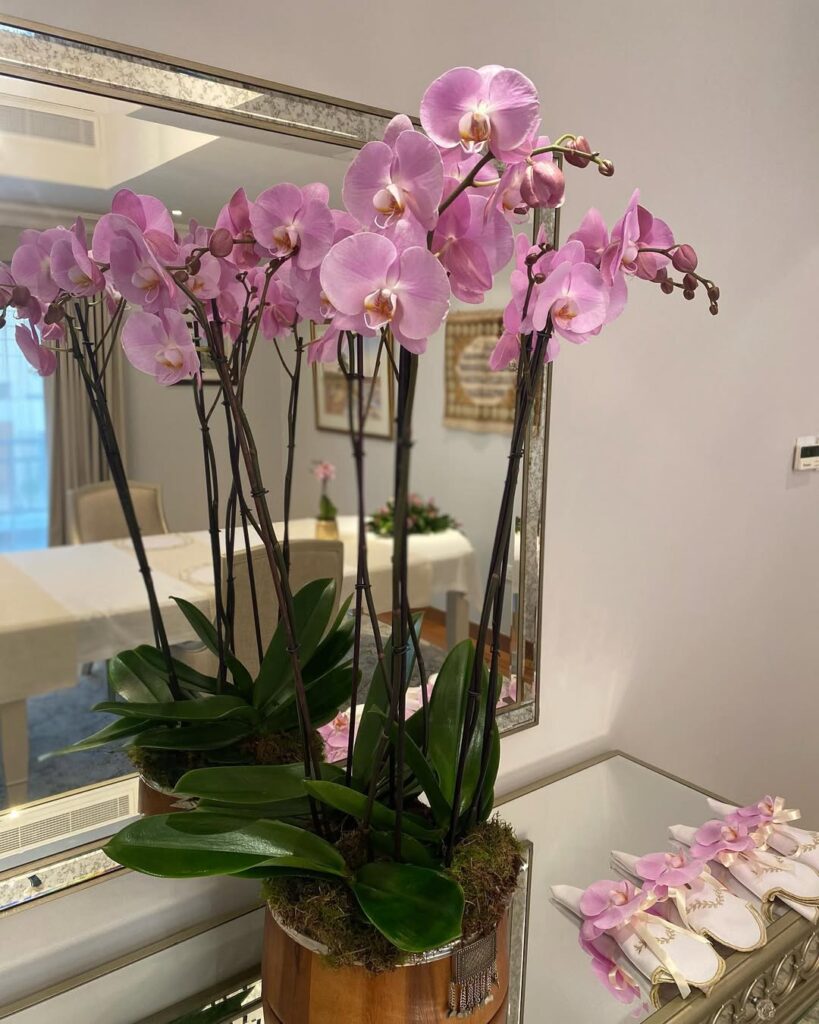
For maximum impact, group orchids in odd numbers (3 or 5) and vary their heights by 4-6 inches using decorative risers or stacked hardcover books.
Creative Container and Planter Solutions
Innovative container solutions transform ordinary orchid displays into stunning focal points that complement your home’s design aesthetic. Don’t limit yourself to traditional pots – try mounting orchids in glass terrariums, hanging them in macramé holders, or securing them to driftwood pieces.
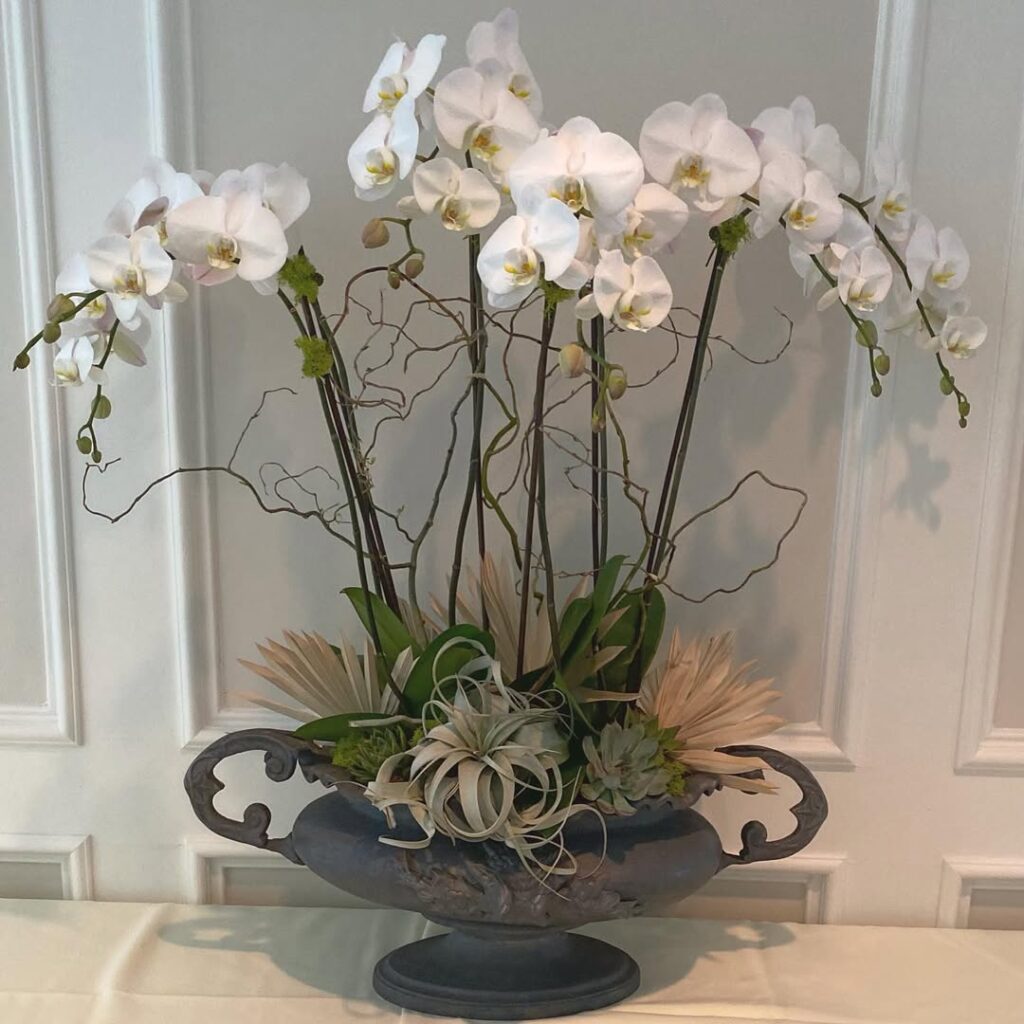
Clear glass containers, 6-8 inches in diameter, work perfectly for showcasing aerial roots while allowing proper airflow. You’ll find that repurposed vessels, like vintage teapots or copper pitchers, add character when paired with proper drainage solutions.
For a modern twist, try stackable geometric planters or wall-mounted display boxes, spacing plants 12 inches apart for ideal growth and visual impact.
Color Coordination: Choosing the Right Orchid Varieties
Beyond selecting the perfect container, the visual impact of your orchid display depends heavily on thoughtful color combinations. When choosing orchid varieties, consider both the flowers’ hues and your room’s existing color palette.
For cool-toned spaces with blues and grays, opt for pure white Phalaenopsis or soft pink Dendrobiums. Warm-toned rooms pair beautifully with deep purple Vandas or salmon-colored Cattleyas. You’ll create striking focal points by grouping three orchids in complementary colors.
Don’t forget about foliage colors, too. Silver-mottled Paphiopedilum leaves can add interesting contrast, while deep green Oncidium foliage provides a classic backdrop for vibrant blooms.
Maintaining Your Orchid Display’s Beauty Year-Round
While orchids naturally cycle through blooming and resting phases, you can maintain an eye-catching display throughout the year with strategic planning and care. Stagger your plants’ bloom times by selecting varieties that flower in different seasons, like Phalaenopsis in winter and Cattleyas in summer.
Monitor each plant’s growth cycle and rotate them within your display area. Move flowering orchids to prominent positions while placing resting plants in supporting roles. You’ll want to refresh moss or bark media every 12-18 months, and trim spent blooms promptly to maintain a polished appearance.
Consider adding air plants or small ferns as companion plants to fill visual gaps between blooming cycles.
